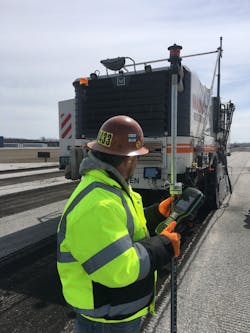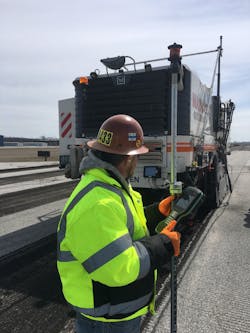Milling Job Finds More Accuracy with Grade Control
Superior Construction of Portage, Ind., has retrofit a milling machine with a 3D laser grade control system to mill asphalt 6 inches down on 4,348 feet of the 9,000-foot-plus main runway at Gary/Chicago International Airport in Gary, Ind.
“This is the first time we’ve used this system,” says Jim Reitz, project manager for Superior. The company, along with milling subcontractor MAMCO (Mid-America Milling Co.), out of Jeffersonville, Ind., is targeting increased accuracy on the mostly FAA-funded job.
Superior and MAMCO conducted a joint training session on the system in Superior’s yard prior to the job.
“It has worked out well,” Reitz says. “It’s definitely more precise [than stringline]. We can do 1,000-foot intervals within an eighth of an inch.”
That includes compensating for tooth wear, “maybe a half-inch per day,” Reitz says, and changing slope in the model when the milling machine changes direction, which is frequently.
“The 3D model has worked to our advantage because stringlines can be extremely sporadic with the depth,” Reitz says. “Stringline imperfections from the crown outward multiply themselves out.”
To further aid accuracy, Superior and MAMCO are milling in 7-foot lanes, every other 7 feet across the runway. “We do it in strips and then connect the dots on each side,” he says. Then, the milling machine will change direction and attack the next strip. “We do 1,200 to 1,500 feet per set-up, back and forth.”
Superior will be paving the runway with concrete using a Wirtgen SP84 slipform paver and the same Leica grade-control system used on the milling machine. It will once again prepare by holding a one-week training session in the yard.
“We’ll pave off the same 3D files we’ve milled off,” Reitz says.

